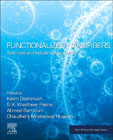
Functionalized Nanofibers: Synthesis and Industrial Applications
Deshmukh, Kalim
Pasha, S. K. Khadheer
Barhoum, Ahmed
Mustansar Hussain, Chaudhery
Functionalized Nanofibers: Synthesis and Industrial Applications presents the latest advances in the fabrication, design, processing, and properties of functionalized nanofibers, for a range of advanced applications. The first section of the book introduces fabrication, mechanisms, and design of functionalized nanofibers, explaining electrospinning and non-electrospinning techniques, optimization of structural designs, surface functionalization techniques, and characterization methods. The subsequent sections of the book focus on specific application areas, highlighting preparation methods and applications of functionalized nanofibers across biomedicine, surfaces and coatings, food, environment, energy, electronics, and textiles. Finally, environmental impact, and safety and legal aspects related to the utilization of functionalized nanofibers are considered. This is a valuable resource for researchers and advanced students with an interest in nanomaterials and nanotechnology, and across other disciplines such as polymer science, chemistry, chemical engineering, and materials science and engineering. This book also supports scientists, engineers, and R&D professionals looking to work with functionalized nanofibers and innovative nanomaterials in an industrial setting Integrates discussion of physics, chemistry, biology, and materials science behind functionalized nanofibers Opens the door to a range of applications across biomedicine, surfaces and coatings, food, environment, energy, electronics, and textiles Analyzes challenges and opportunities relating to environmental, health, and safety issues INDICE: SECTION 1: Fabrication, Mechanisms, and Design Optimization of Functionalized Nanofibers 1. Electrospinning and non-electrospinning techniques for the fabrication of functionalized nanofibers: Mechanisms, process parameters, and key technical challenges 2. Optimization of structural designs: Processing, properties and applications of random, aligned, porous, core shell, and hollow nanofibers 3. Surface functionalization techniques and characterization methods of electrospun nanofibers: Current challenges and future opportunities SECTION 2: Functionalized Nanofibers in Biomedical Industry 4. Functionalized nanofibers for tissue engineering and regenerative medicine: Recent advances, prospects and challenges 5. Functionalized nanofibers for antimicrobial applications: Current status and future directions 6. Recent progress in functionalized nanofiber-based bio-sensing devices and drug delivery systems: Prospects and challenges 7. Advances and perspectives of functionalized nanofibers in wound healing and wound dressing applications SECTION 3: Functionalized Nanofibers in Surfaces and Coatings 8. Surface coatings of electrospun nanofibers for property enhancement: Synthesis, characterizations, and applications 9. Recent trends in functionalized nanofiber based anticorrosive coatings 10. Functionalized nanofibers for realization of superhydrophobic surfaces SECTION 4: Functionalized Nanofibers in Food Industry 11. Advances and perspectives of functionalized nanofibers towards food packaging 12. Recent progress in functionalized nanofibers as sensors for monitoring food quality: Prospects and challenges 13. Current developments, perspectives, and applications of functionalized nanofibers in agriculture industry SECTION 5: Functionalized Nanofibers in Environmental Industry 14. Functionalized nanofibers for adsorption of heavy metal ions: Recent advances, prospects, and challenges 15. Functionalized nanofibers for remediation of organic pollutants and catalytic applications: Advances, challenges and future trends 16. Recent developments in functionalized nanofibers for water treatment and purification 17. Functionalized nanofibers for gas and volatile compounds sensing: Recent progress and challenges 18. Functionalized nanofibrous mats for gas separation applications: Advances, challenges, and future prospects SECTION 6: Functionalized Nanofibers in Energy Industry 19. Advances in functionalized nanofibers for lithium-ion battery applications 20. Functionalized nanofibers for high performance supercapacitor applications: Recent developments and future scope 21. Recent developments in functionalized nanofibers for hydrogen storage and conversion: Perspectives and outlook 22. Functionalized nanofibers for piezoelectric energy harvesting applications: Current status and future directions 23. Recent progress in functionalized nanofibers for fuel cell applications 24. Recent trends in functionalized nanofibers for solar cell applications: Challenges, opportunities, and future directions SECTION 7: Functionalized Nanofibers in Electronics and Electrical Industry 25. Advances in functionalized nanofibers for photonics, optoelectronics, and microelectronic device applications 26. Recent advances in functionalized nanofibers for EMI shielding and microwave absorption applications SECTION 8: Functionalized Nanofibers in Textile Industry 27. Functionalized nanofibers for protective clothing applications: Recent trends, opportunities, and future perspectives 28. Advances in functionalized nanofibers as fire retardant fabrics: Opportunities and challenges SECTION 9: Environmental, Legal, Health and Safety Issues of Functionalized Nanofibers 29. Environmental impact, safety, and legal aspects of functionalized nanofibers
- ISBN: 978-0-323-99461-3
- Editorial: Elsevier
- Encuadernacion: Rústica
- Fecha Publicación: 01/04/2023
- Nº Volúmenes: 1
- Idioma: Inglés
